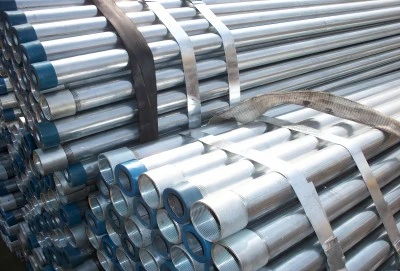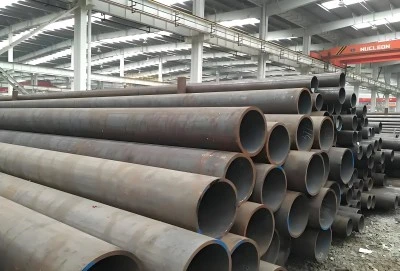In the steel pipe industry, two widely recognized standards, each with its own application scope, are BS 1387 and ASTM A53. Engineers, contractors, and procurement specialists in a variety of industries need to be aware of the differences between these standards.
Steel tubes and tubulars that are suitable for screwing into BS 21 pipe threads are the primary subjects of the British Standard BS 1387. For regular services, steel pipes and tubes made of carbon steel and fine grain steel are covered by this standard. In general engineering, plumbing, heating, and other applications, BS 1387 pipe are frequently utilized. The standard applies to pipes that are welded or seamless and have nominal sizes of 15 to 150 millimeters.
The American Society for Testing and Materials standard ASTM A53, on the other hand, has a broader scope. It covers mechanical and pressure-related carbon steel pipes, both welded and seamless. There are three types of ASTM A53 pipes on the market: Types F (electric resistance welded), E (furnace butt welded), and S (seamless) ASTM A53 has a wider size range, encompassing nominal pipe sizes from NPS 1/8 to NPS 26.
While carbon steel pipes are covered by both standards, ASTM A53 allows for greater adaptability in terms of manufacturing procedures and size ranges. ASTM A53 pipes are suitable for a wider range of applications thanks to their broader scope. These include high-pressure systems, structural applications, and oil and gas pipelines.
It is important to note that BS 1387 is better suited for applications where threaded connections are preferred because it focuses more on pipes designed for threading to BS 21 specifications. Although it is also suitable for threading, ASTM A53 is frequently utilized in settings where mechanical or welded joints are more prevalent.
|
|
|
Manufacturing process:
There are some similarities between the BS 1387 and ASTM A53 pipe manufacturing processes, but there are also significant differences. The properties and performance of the pipes can be affected by these differences in various applications.
Typically, seamless pipe-making or the electric resistance welding (ERW) process are used to make BS 1387 pipe. The ERW procedure involves welding the seam with electric current and shaping the steel strip into a tubular shape. By making a hollow tube out of a heated solid steel billet, seamless pipes are made.
There are more manufacturing options with ASTM A53. It includes furnace-butt welded pipes (Type F) as well as ERW (Type E) and seamless (Type S) processes. For pipes with smaller diameters, the furnace-butt welding method involves heating the edges of a steel strip in a furnace and pressing them together to form a weld.
Another area where standards differ is heat treatment. To normalize the weld and heat-affected zones, ASTM A53 requires that all welded pipes (Types E and F) undergo heat treatment. The entire pipe is heated to a certain temperature and then cooled under controlled conditions in this procedure. This intensity therapy assists with working on the consistency of the line's properties and lessen lingering stresses from the welding system.
However, heat treatment for welded pipes is not explicitly required by BS 1387. Heat treatment, on the other hand, may be chosen by manufacturers to improve the properties of the pipe or satisfy specific customer requirements.
End preparation and surface finish are required by both standards. Pre-cut threads in accordance with BS 21 or plain ends suitable for threading are typically provided with BS 1387 pipes. Depending on the intended use, ASTM A53 pipes can be supplied with plain, threaded, or prepared for welding ends.
The mechanical properties, weld quality, and overall performance of the pipes may be affected by the various manufacturing processes. The more stringent heat treatment requirements of ASTM A53 for welded pipes frequently lead to properties that are more consistent across the pipe body and weld areas. However, applications where threaded fitting assembly is a priority favor BS 1387 pipes due to their focus on threading compatibility.
Test methods:
The various focuses and applications of BS 1387 pipe and ASTM A53 pipes are reflected in their respective testing requirements. While both standards include a variety of tests to guarantee the pipes' quality and performance, their approaches differ significantly.
Tests of Tension: To determine the material's strength, both standards require tensile testing. The minimum tensile strength and yield strength values for the pipes are outlined in BS 1387. The addition of maximum tensile strength limits to ASTM A53 ensures that the pipe's behavior under load remains consistent.
Test of Flattening: For determining the quality of the weld and the ductility of welded pipes, this test is essential. Flattening tests are included in both standards, but the procedures and acceptance criteria are slightly different. The flattening test requirements in ASTM A53 are more specific, with specific criteria for various pipe sizes and types.
Hydrostatic Analysis: Hydrostatic testing is required by both standards to ensure that the pipe can withstand pressure without leaking. However, the test durations and pressures may vary. While ASTM A53 calculates the test pressure based on the material's specified minimum yield strength, BS 1387 typically specifies a test pressure based on the nominal size and wall thickness of the pipe.
NDT: Non-destructive testing NDT requirements are more extensive in ASTM A53, especially for welded pipes. For all Type E (ERW) pipes, it requires either eddy current or ultrasonic testing. Although manufacturers may perform these tests to meet customer specifications or ensure quality, BS 1387 does not explicitly mandate such extensive NDT.
Compositional Chemistry: Limits on the chemical composition of the steel used in the pipes are set by both standards. However, ASTM A53 typically specifies more in-depth chemical composition requirements, such as limits for additional elements that have the potential to influence the properties and weldability of the pipe.
Test of Bend: A bend test is included in BS 1387 to determine whether the pipe can withstand cold bending without cracking or other defects. For applications where the pipe may need to be bent during installation, this test is especially important. There is no specific bend test requirement in ASTM A53.
The different focuses of BS 1387 and ASTM A53 are reflected in the different testing methods and requirements. The testing schedule for BS 1387 is designed to ensure that the pipes are suitable for threading and other general engineering applications. The more extensive testing method of ASTM A53, on the other hand, aims to guarantee the pipes' performance in a wider range of mechanical and pressure applications.
Application scenarios:
Application scenarios for BS 1387 pipe and ASTM A53 pipes differ from one another in some ways, reflecting the distinct features and focus of each standard.
The following industries make extensive use of BS 1387 pipes:
1. Systems for plumbing: These pipes are frequently used in plumbing installations, both at home and in businesses, particularly in nations that adhere to British standards. They are excellent for use with standard plumbing fittings because they are compatible with BS 21 threads.
2. Heating Equipment: The connection of radiators and the installation of boilers are two common applications for BS 1387 pipes in central heating systems.
3. Systems for Fighting Fires: Due to their capacity to bear pressure, pipes in the medium and heavy series are frequently utilized in fire sprinkler systems.
4. Engineering in general: The construction industry makes use of these pipes for scaffolding, temporary structures, and other light industrial applications.
Due to their expanded scope and more stringent testing requirements, ASTM A53 pipes are utilized in a wider variety of applications:
1. The Oil and Gas Sector: Oil and gas pipelines, both onshore and offshore, frequently make use of ASTM A53 pipes. Their capacity to endure high tensions and differed ecological circumstances makes them reasonable for shipping raw petroleum, flammable gas, and refined items.
2. Chemical Treatment: Due to their strength and resistance to corrosion, these pipes are utilized in chemical plants for the transportation of various gases and fluids.
3. Making Electricity: In power plants, ASTM A53 pipes are used for high-pressure applications like cooling water systems and steam lines.
4. Applications in the construction and structure: In the construction of buildings, particularly high-rise structures and industrial structures, the pipes serve as structural members.
5. Treatment and Distribution of Water: Municipal water systems use ASTM A53 pipes for both supply and wastewater applications.
6. HVAC Equipment: Due to their variety of sizes and pressure ratings, ASTM A53 pipes are frequently chosen for large commercial and industrial HVAC installations.
The choice between BS 1387 and ASTM A53 pipes is frequently determined by project specifications, local regulations, and regional customs. BS 1387 pipes are more frequently used in building services applications in nations that have traditionally followed British standards. ASTM A53 pipes, on the other hand, are more common in international and North American projects, particularly those involving the oil and gas industry.
It is important to note that these standards are considered interchangeable in some situations, particularly when it comes to general-purpose piping. However, the specific requirements of each standard should be carefully considered for critical applications or those involving high pressures to ensure that the chosen pipe meets all necessary performance criteria.
BS 1387 Pipe supplier:
For the success of the project, selecting a dependable and effective supplier of BS 1387 pipe is essential. LONGMA GROUP is one of the most well-known suppliers in this industry. It is known for its dedication to quality and quick delivery times.
With its remarkably quick delivery time, LONGMA GROUP stands out in the market.
Contact LONGMA GROUP at info@longma-group.com if you want to learn more about the company's offerings or talk about specific needs. It's best to be clear about your project's requirements when you reach out, including the necessary pipe dimensions, quantities, and delivery times. This will assist in obtaining precise delivery estimates and quotes.
Although LONGMA GROUP's lightning-fast delivery times are impressive, it is always a good idea to anticipate your needs and place your orders as far in advance as possible. This can help you make sure you have the materials you need when your project needs them, so you don't have to worry about being late or disrupted.














